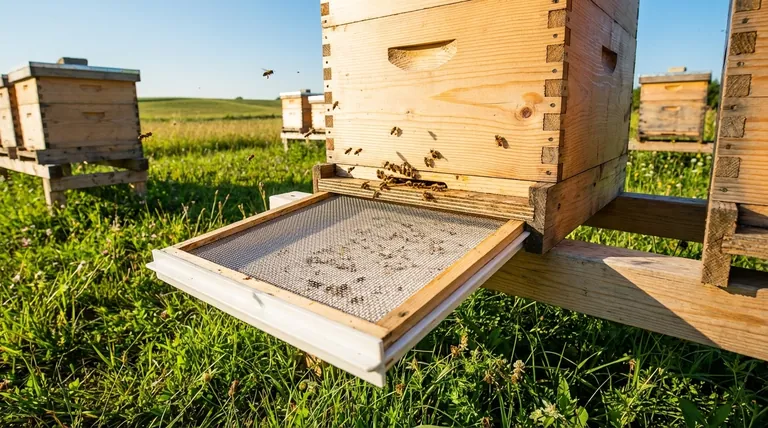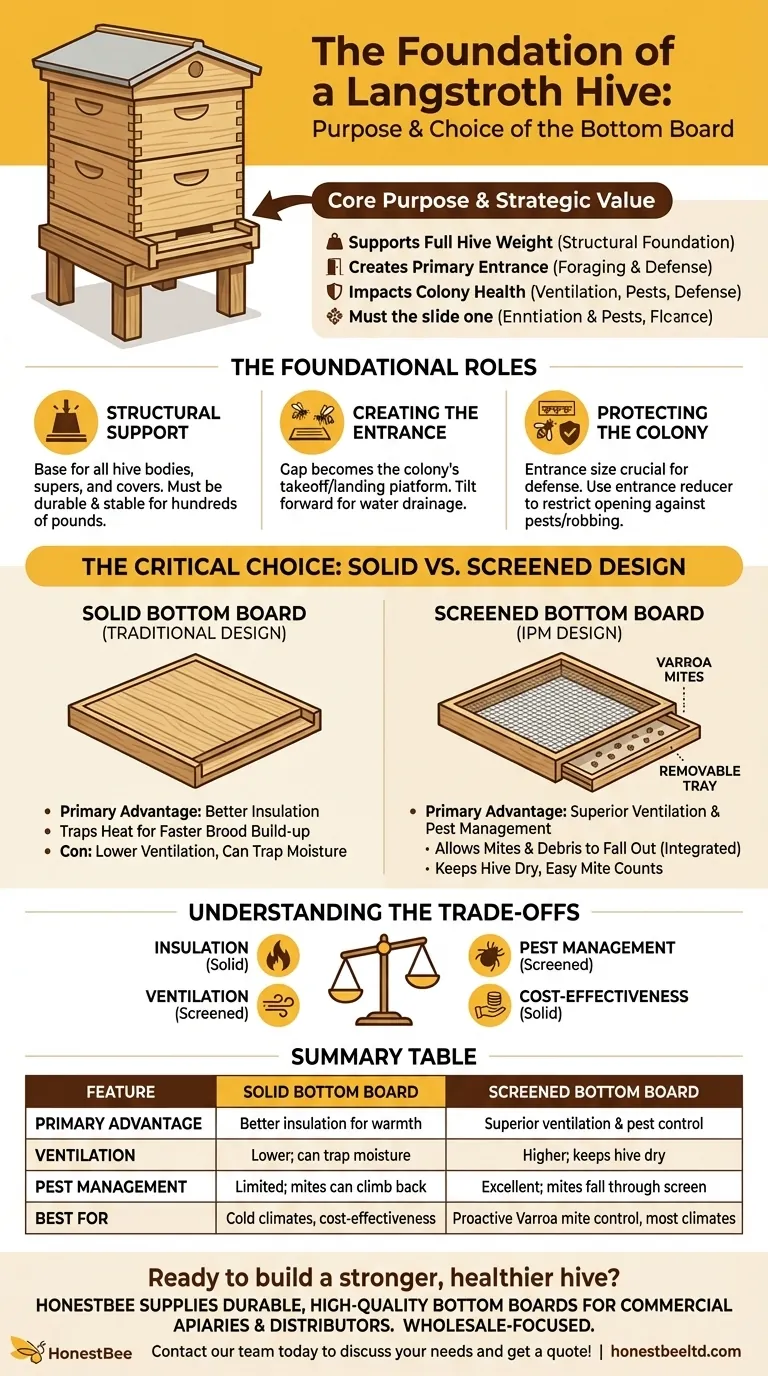At its core, the bottom board serves as the foundational floor of a Langstroth beehive. It is the component that supports the full weight of the hive boxes above it while also creating the primary entrance and exit for the honey bees.
The bottom board is far more than just a floor; it is a critical management tool. Your choice between a solid or screened design is a strategic decision that directly impacts colony health by influencing ventilation, pest control, and hive defense.

The Foundational Roles of the Bottom Board
Providing Structural Support
The bottom board is the base of the entire hive structure. All other components—the hive bodies, supers, and covers—rest directly on it.
This piece must be durable and stable, capable of supporting a hive that can weigh hundreds of pounds when full of bees, brood, and honey. It is typically placed on a stand to raise it off the damp ground, prolonging the life of the wood.
Creating the Primary Entrance
When a hive body is placed on the bottom board, a gap is created at the front that serves as the main entrance. This becomes the colony's takeoff and landing platform for all foraging activities.
Proper setup requires tilting the entire hive slightly forward. This ensures that any rainwater entering the landing board drains out rather than pooling inside the hive.
Protecting the Colony
The size of this entrance is a critical factor in the colony's ability to defend itself. Beekeepers often use an entrance reducer, a small block of wood with different-sized notches, to restrict the opening.
This is especially important for new or small colonies, as a smaller entrance is easier to guard against intruders like wasps, robbing bees, and mice.
The Critical Choice: Solid vs. Screened
The most significant decision regarding your bottom board is whether to use a solid or a screened design.
The Solid Bottom Board
A solid bottom board is a simple, solid piece of wood. It is the traditional design and is often slightly cheaper to build or buy.
Its primary advantage is insulation. By creating a solid floor, it can help the colony retain heat, which may contribute to a faster build-up of the brood population in early spring.
The Screened Bottom Board
A screened bottom board (or Integrated Pest Management board) consists of a wood frame with a section of sturdy wire mesh.
Its main purpose is to improve hive ventilation and assist in pest management. The screen allows debris and, most importantly, Varroa mites to fall out of the hive, reducing the pest load on the colony. It also provides an easy way to perform "mite drop" counts on a removable tray below the screen to assess infestation levels.
Understanding the Trade-offs
Choosing a bottom board is not about right or wrong, but about understanding the consequences of each design for your specific climate and management style.
Ventilation vs. Insulation
A solid bottom board provides better insulation but can trap moisture, especially during winter. This can lead to condensation and mold if ventilation is not managed through other means.
A screened bottom board provides excellent passive ventilation, helping to keep the hive dry. However, in extremely cold climates, some beekeepers argue it can create too much of a draft, though many successful northern beekeepers use them year-round without issue.
Pest Management
This is where the screened bottom board has a decisive advantage. The ability for Varroa mites to physically fall out of the colony is a key part of an integrated pest management strategy.
With a solid board, mites that are groomed off a bee simply fall to the floor and can climb back onto another host.
Making the Right Choice for Your Colony
Your choice of bottom board should align directly with your beekeeping goals and local environmental conditions.
- If your primary focus is cost-effectiveness and maximum heat retention: A solid bottom board is a viable and traditional choice, especially if you have a robust plan for managing ventilation.
- If your primary focus is proactive pest management and superior ventilation: A screened bottom board is the modern standard and provides invaluable diagnostic and passive control benefits.
- If you are a new beekeeper seeking flexibility: Start with a screened bottom board; it provides more information and management options for controlling the hive's biggest threats.
Ultimately, selecting the right bottom board is your first strategic decision in promoting a healthy and resilient colony.
Summary Table:
| Feature | Solid Bottom Board | Screened Bottom Board |
|---|---|---|
| Primary Advantage | Better insulation for warmth | Superior ventilation & pest control |
| Ventilation | Lower; can trap moisture | Higher; keeps hive dry |
| Pest Management | Limited; mites can climb back | Excellent; mites fall through screen |
| Best For | Cold climates, cost-effectiveness | Proactive Varroa mite control, most climates |
Ready to build a stronger, healthier hive? The foundation of a thriving colony starts with the right equipment. At HONESTBEE, we supply durable, high-quality bottom boards—both solid and screened designs—to commercial apiaries and beekeeping equipment distributors. Our wholesale-focused operations ensure you get the reliable supplies your business needs to succeed. Contact our team today to discuss your needs and get a quote!
Visual Guide

Related Products
- Australian Pine Wood Langstroth Screen Bottom Board for Wholesale
- Langstroth Screen Bottom Board for Beekeeping Wholesale
- Professional Drop-Style Hive Handles for Beekeeping
- HONESTBEE Professional Frame Wiring Board and Jig
- HONESTBEE Wooden Bee Escape Board with Triangle Mesh Design for Beekeeping
People Also Ask
- Are screened bottom boards necessary for beekeeping? A Strategic Choice for Modern Hive Health
- How should the screened bottom board be used throughout the year? A Guide for Healthy Hives
- What additional benefit does a screened bottom board offer? Boost Hive Health & Mite Control
- How does a screened bottom board benefit the hive during the summer? Boost Ventilation & Pest Control
- What are the assembly options for the Cypress Screened Bottom Board? Ready-to-Use for Immediate Hive Health



















